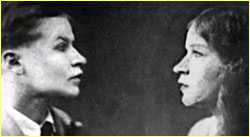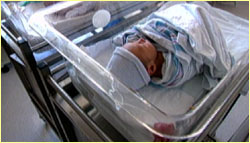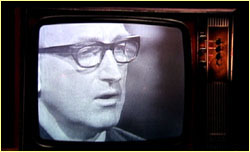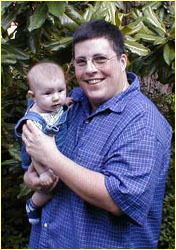|

|

|
|
|
 Intersexuals, formerly called hermaphrodites, have
been around as long as humans have, though until
recently few felt comfortable enough to "come out"
about their conditions.
Intersexuals, formerly called hermaphrodites, have
been around as long as humans have, though until
recently few felt comfortable enough to "come out"
about their conditions.
|
Two Sexes Are Not Enough
by Anne Fausto-Sterling
In 1843 Levi Suydam, a 23-year-old resident of Salisbury,
Connecticut, asked the town's board of selectmen to allow
him to vote as a Whig in a hotly contested local election.
The request raised a flurry of objections from the
opposition party, for a reason that must be rare in the
annals of American democracy: It was said that Suydam was
"more female than male," and thus (since only men had the
right to vote) should not be allowed to cast a ballot. The
selectmen brought in a physician, one Dr. William Barry, to
examine Suydam and settle the matter. Presumably, upon
encountering a phallus and testicles, the good doctor
declared the prospective voter male. With Suydam safely in
their column, the Whigs won the election by a majority of
one.
A few days later, however, Barry discovered that Suydam
menstruated regularly and had a vaginal opening. Suydam had
the narrow shoulders and broad hips characteristic of a
female build, but occasionally "he" felt physical
attractions to the "opposite" sex (by which "he" meant
women). Furthermore, "his feminine propensities, such as
fondness for gay colors, for pieces of calico, comparing and
placing them together, and an aversion for bodily labor and
an inability to perform the same, were remarked by many."
(Note that this 19th-century doctor did not
distinguish between "sex" and "gender." Thus he considered a
fondness for piecing together swatches of calico just as
telling as anatomy and physiology.) No one has yet
discovered whether Suydam lost the right to vote. Whatever
the outcome, the story conveys both the political weight our
culture places on ascertaining a person's correct "sex" and
the deep confusion that arises when it can't be easily
determined.
European and American culture is deeply devoted to the idea
that there are only two sexes. Even our language refuses
other possibilities; thus to write about Levi Suydam I have
had to invent conventions—s/he and h/er to denote
individuals who are clearly neither/both male and female or
who are, perhaps, both at once. Nor is the linguistic
convenience an idle fancy. Whether one falls into the
category of man or woman matters in concrete ways. For
Suydam—and still today for women in some parts of the
world—it meant the right to vote. It might mean being
subject to the military draft and to various laws concerning
the family and marriage. In many parts of the United States,
for example, two individuals legally registered as men
cannot have sexual relations without breaking antisodomy
laws.
 Male and female form the extremes of a biological
continuum that features many types of intersex
conditions.
Male and female form the extremes of a biological
continuum that features many types of intersex
conditions.
|
|
But if the state and legal system has an interest in
maintaining only two sexes, our collective biological bodies
do not. While male and female stand on the extreme ends of a
biological continuum, there are many other bodies, bodies
such as Suydam's, that evidently mix together anatomical
components conventionally attributed to both males and
females. The implications of my argument for a sexual
continuum are profound. If nature really offers us more than
two sexes, then it follows that our current notions of
masculinity and femininity are cultural conceits.
Reconceptualizing the category of "sex" challenges cherished
aspects of European and American social organization.
Indeed, we have begun to insist on the male-female dichotomy
at increasingly early stages, making the two-sex system more
deeply a part of how we imagine human life and giving it the
appearance of being both inborn and natural. Nowadays,
months before the child leaves the comfort of the womb,
amniocentesis and ultrasound identify a fetus's sex. Parents
can decorate the baby's room in gender-appropriate style,
sports wallpaper—in blue—for the little boy,
flowered designs—in pink—for the little girl.
Researchers have nearly completed development of technology
that can choose the sex of a child at the moment of
fertilization. Moreover, modern surgical techniques help
maintain the two-sex system. Today children who are born
"either/or—neither/both"—a fairly common
phenomenon—usually disappear from view because doctors
"correct" them right away with surgery. In the past,
however, intersexuals (or hermaphrodites, as they were
called until recently), were culturally acknowledged.
|
 Within 24 hours of the birth of an intersex baby,
doctors typically operate to assign the newborn a
gender.
Within 24 hours of the birth of an intersex baby,
doctors typically operate to assign the newborn a
gender.
|
Hermaphroditic heresies
In 1993 I published a modest proposal suggesting that we
replace our two-sex system with a five-sex one. In addition
to males and females, I argued, we should also accept the
categories herms (named after "true" hermaphrodites), merms
(named after male "pseudohermaphrodites"), and ferms (named
after female "pseudohermaphrodites"). [Editor's note:
A "true" hermaphrodite bears an ovary and a testis, or a
combined gonad called an ovo-testis. A "pseudohermaphrodite"
has either an ovary or a testis, along with genitals from
the "opposite" sex.] I'd intended to be provocative, but I
had also been writing tongue in cheek and so was surprised
by the extent of the controversy the article unleashed.
Right-wing Christians somehow connected my idea of five
sexes to the United Nations-sponsored Fourth World
Conference on Women, to be held in Beijing two years later,
apparently seeing some sort of global conspiracy at work.
"It is maddening," says the text of a
New York Times advertisement paid for by the Catholic
League for Religious and Civil Rights, "to listen to
discussions of 'five genders' when every sane person knows
there are but two sexes, both of which are rooted in
nature."
 Sexologist John Money, who features largely in the
NOVA program "Sex: Unknown," was "horrified" at
Fausto-Sterling's proposal that there be five sexes.
Sexologist John Money, who features largely in the
NOVA program "Sex: Unknown," was "horrified" at
Fausto-Sterling's proposal that there be five sexes.
|
|
[Sexologist] John Money was also horrified by my article,
although for different reasons. In a new edition of his
guide for those who counsel intersexual children and their
families, he wrote: "In the 1970's nurturists ... became ...
'social constructionists.' They align themselves against
biology and medicine ... They consider all sex differences
as artifacts of social construction. In cases of birth
defects of the sex organs, they attack all medical and
surgical interventions as unjustified meddling designed to
force babies into fixed social molds of male and female ...
One writer has gone even to the extreme of proposing that
there are five sexes ... (Fausto-Sterling)."
Meanwhile, those battling against the constraints of our
sex/gender system were delighted by the article. The science
fiction writer Melissa Scott wrote a novel entitled
Shadow Man, which includes nine types of sexual
preference and several genders, including fems (people with
testes, XY chromosomes, and some aspects of female
genitalia), herms (people with ovaries and testes), and mems
(people with XX chromosomes and some aspects of male
genitalia). Others used the idea of five sexes as a starting
point for their own multi-gendered theories.
|
 More and more intersexuals are speaking out about
their experiences, including Max Beck, seen here
with his daughter Alder (see
My Life as an Intersexual).
More and more intersexuals are speaking out about
their experiences, including Max Beck, seen here
with his daughter Alder (see
My Life as an Intersexual).
|
Clearly I had struck a nerve. The fact that so many people
could get riled up by my proposal to revamp our sex/gender
system suggested that change (and resistance to it) might be
in the offing. Indeed, a lot has changed since 1993,
and I like to think that my article was one important
stimulus. Intersexuals have materialized before our very
eyes, like beings beamed up onto the Starship Enterprise.
They have become political organizers lobbying physicians
and politicians to change treatment practices. More
generally, the debate over our cultural conceptions of
gender has escalated, and the boundaries separating
masculine and feminine seem harder than ever to define. Some
find the changes under way deeply disturbing; others find
them liberating.
I, of course, am committed to challenging ideas about the
male/female divide. In chorus with a growing organization of
adult intersexuals, a small group of scholars, and a small
but growing cadre of medical practitioners, I argue that
medical management of intersexual births needs to change.
First, let there be no unnecessary infant surgery (by
necessary I mean to save the infant's life or
significantly improve h/er physical well-being).
Second, let physicians assign a provisional sex (male
or female) to the infant (based on existing knowledge of the
probability of a particular gender identity
formation—penis size be damned!). Third, let
the medical care team provide full information and long-term
counseling to the parents and to the child. However
well-intentioned, the methods for managing intersexuality,
so entrenched since the 1950s, have done serious harm.

|
|
Dr. Anne Fausto-Sterling is a biologist and
historian at Brown University. The passages above
were excerpted from her book
Sexing the Body: Gender Politics and the
Construction of Sexuality.
©1999 by Anne Fausto-Sterling. Reprinted by
permission of Basic Books. All rights
reserved.
|
Photos: (1-2) Antique photographs of intersexual circus
performers from Freaks, Geeks and Strange Girls by
Randy Johnson, Jim Secreto, and Teddy Varnell. Honolulu:
Hardy Marks Publications, 1995; (3-4, 6) WGBH/NOVA; (5)
Courtesy of Max Beck.
My Life as an Intersexual
|
Share Your Story
|
Two Sexes Are Not Enough
The Intersex Spectrum
|
How Is Sex Determined?
|
Resources
Transcript
|
Site Map
|
Sex: Unknown Home
Search |
Site Map
|
Previously Featured
|
Schedule
|
Feedback |
Teachers |
Shop
Join Us/E-Mail
| About NOVA |
Editor's Picks
|
Watch NOVAs online
|
To print
PBS Online |
NOVA Online |
WGBH
©
| Updated October 2001
|
|
|
|